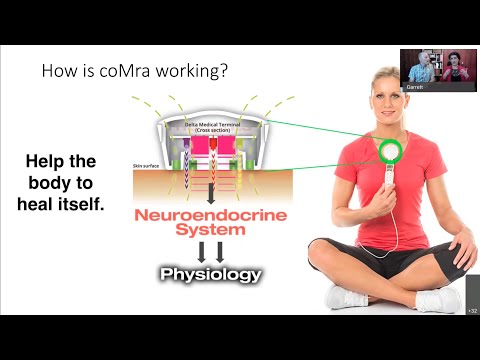*This is the webinar transcript, you can watch the video recording HERE.
Garrett Murrin: Welcome! Today we’re going to go over hormones and specifically we’re going to look at supporting hormone balance in the body with coMra Therapy.
Now, not everybody here perhaps is familiar with coMra Therapy, so today what this presentation is about is a medical technology called coMra Therapy. We will get into what that’s about and how it supports the balance of hormones in the body through the endocrine system. Although coMra Therapy does more than this in the body, this is what we’re going to look at today.
Who is This Webinar For?
Well, perhaps if you’re interested in the topic of hormones or you might suspect that you have a hormonal imbalance, or you know someone who has, or if you already know you do have it or something related. This is going to be a presentation for you and shortly we’ll show you a sampling of some common symptoms for men and women, then you’ll be able to look at that list as well and that’ll give you a better idea.
Also we wanted to make clear in this webinar that this is an introductory webinar. What we’re going to do today? Today we are going to lay a foundation for our approach. This is a very simple and balanced approach to support a very fine balancing of a complex system. I’m very confident that you’re going to find this a very different approach than what you may be used to up to this point.
Who Are the Hosts?
My name is Garrett Murrin and I’m here today with my wife Avril Murrin We’ve been with Radiant Life Technologies over a decade now. I work mainly in North America and Avril works with me. We do our best in terms of support for practitioners.
What Is Your State of Being?
Avril Murrin: So, right now we’re going to take a pause just to land here. Whether it’s the morning time for you and you’ve been busy getting ready or it’s the evening time …we’re just going to check in with our state of being.
What is your state of being right now? How are you feeling? Have you registered your mood today? Do you know what are you feeling in your body? Is there any anxiety, are you tired, energized or happy…? Take a pause and check in…See if you can register what’s going on for you…Whatever our state of being is, our bodies are listening and responding through our hormones.
- Who is This Webinar For?
- Who Are the Hosts?
- What Is Your State of Being?
- What Does the Word “Hormone” Mean?
- Common Symptoms of Hormonal Imbalance
- Where Does the Disease Start?
- “Spiritual beings on a human journey.”
- The Body Reflects Your State of Being Through Hormones
- The Internal Monologue
- When I Have Trouble Sleeping …
- Coping Mechanisms in Stressful Situations?
- How is coMra Therapy Working?
- More About Endocrine Disorders
- coMra Treatment Approach to Endocrine Disorders
- Birth Control Pill and Other Medications
- Endocrine Disrupting Chemicals
What Does the Word “Hormone” Mean?
Garrett: At the beginning, I said we’re going to use some certain terms here and along the way we’re going to explain them for people who may not be familiar. We start with the word “hormone”. What is this word, where does it come from? When you look at the word “hormone”, the definition is:
“An organic compound produced in animal bodies, which is us, to regulate activity and behavior.”
When we look at the etymology of the word, where it comes from… it is a Greek word. It sets things in motion, impel, urge on an impulse… so you get a sense of what this word “hormone” is about. It’s really about getting things going, setting things in motion. Like I said, we’ll get into more of this but we just wanted to start here because it really sets the trajectory ahead. Going back to the etymology of the word – it comes from Greek and some other roots and it really is about getting things in motion in the body.
Common Symptoms of Hormonal Imbalance
Avril: Now, we were going to look at a list of some of the common symptoms of a hormonal imbalance. This is certainly not a comprehensive list as there’s a lot more that can go on but even just this sampling gives you an idea.
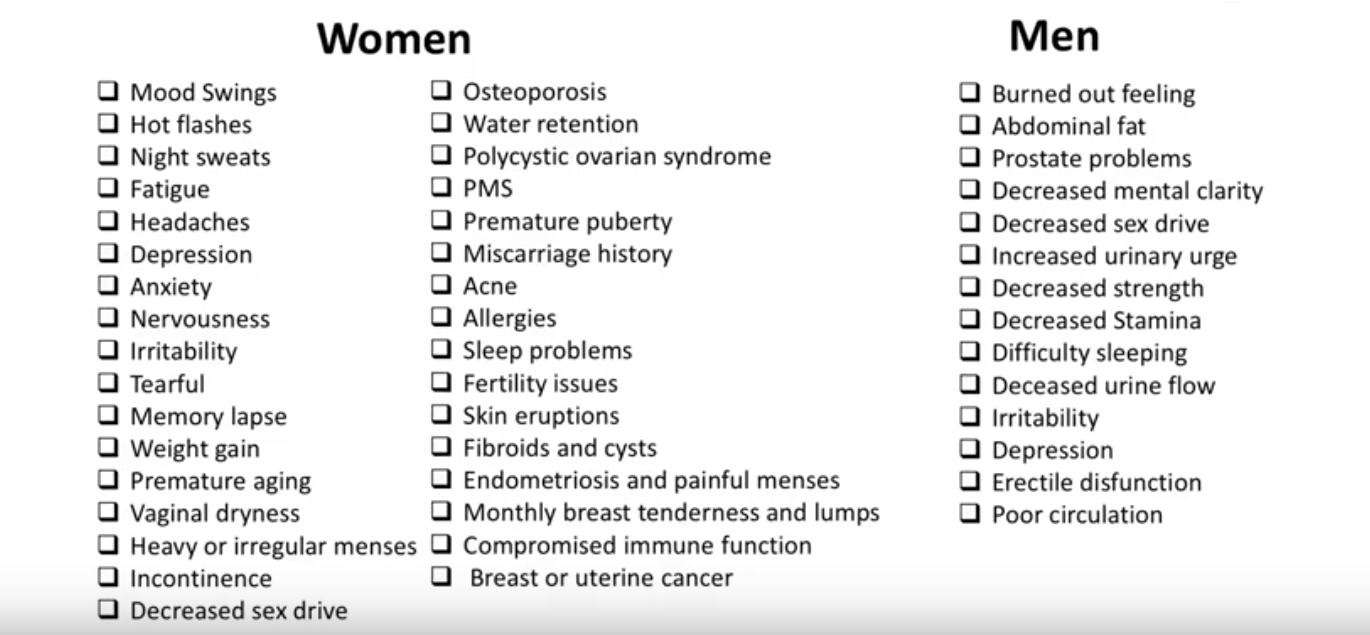
There can be much more going on in the body connected to the endocrine system and the hormones. So, some of the things on the list both men and women can experience them like trouble sleeping, allergies etc. We will not go into anything in particular on this list. We’re looking at it like as a whole and we’re looking at a more fundamental level – what’s behind all of these issues.
Garrett: The reason we come from this angle is because a lot of times, conventionally speaking of course, if someone has an imbalance in their hormones they’ll go and get a diagnosis. It could be a very long list with the charts and figures and things like “hormone X is 300% up” and “hormone Y is 50% down”. In that situation you get this word map below where it’s all very complex. Only a professional can really work through it with you if you’re experiencing it.
We want to take a little different approach than that today. Not to exclude this but again, we’re going to go to this more fundamental level so we can get past the complexity to where it all emanates from. We’re going to lay a foundation, we need to lay some pieces in place in order to go on this journey.
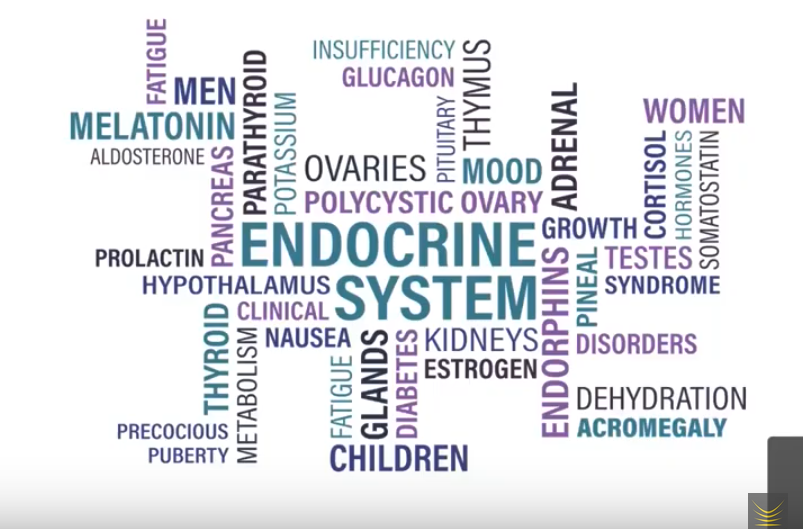

Where Does the Disease Start?
Avril: Where we’re going to start is with the body. It is an effect or an expression, it’s not the cause. When there is a disease in the physical body it’s not where the cause is, it’s not where the disease starts. In the foreword of our coMra user guide, it does go through this and explains that in earlier times people did use a different model of looking at a disease. They didn’t just look at the physical body, they were looking deeper than that and saying well disease actually starts psychologically first with the emotions and behavioral patterns.
This is really where we want to look and then if we don’t become aware of it on this level then it will start manifesting in the body because it’s trying to actually get our attention, something is trying to get our attention. The disease is an expression, an effort to help us tune into and uncover an actual gap in our knowledge. So, it’s there for us to learn about something, something new that we don’t know about ourselves yet.
“Health and Holismin the 21st century” is a guidebook written by Théun Mares, who is the founder of Radiant Life Technologies. It does include a list of diseases and their causes at a deeper level – at behavioral, emotional and perception level. So, if anybody is ever interested in that, you can use that book as a guide for yourself and for your own learning.


Garrett: Now look at the picture above: if I poke my finger with the cactus spine, I’m not going to be upset at my finger. I’m not going to look to my finger for the cause. Obviously, I took an action that caused something that happened in my finger. So, that’s the kind of logic we’re looking at. That’s not to blame, that’s just а matter of fact.
“Spiritual beings on a human journey.”
Avril: When we talk about expression then there are definitely some good expressions here with these little babies:


These are tiny new people to the world but they’ve definitely got a lot going on behind those little bodies. “We are not human beings on a spiritual journey, we are spiritual beings on a human journey” and these babies can definitely express that.
Garett: There’s obviously intelligence inside that body which exceeds the age of the physical body. It’s very evident from those pictures, I love those pictures.
The Body Reflects Your State of Being Through Hormones
Avril: What do we mean when we say this? We were just talking about disease starting in the thoughts and emotions and then the endocrine system will actually pick up on these things and then will translate it into the physical body.
An example – last summer we were out at our friend’s land in the mountains. There are some bears that are around the area. So, you’re already pretty wide awake when you’re out and about in the woods there and you take a bear spray or something like that. So, we were out on a walk one day and quite away from her the main part of the property, there were no cars or anything, just this bottle of bear spray with us. When we are out there I am always kind of looking around as there are lots of trees and bushes. I am always looking and trying to see in between the trees if there is anything there.
This one day we were walking up this little hill and all of a sudden, I saw something. I looked and I looked again and was like “Oh, that’s a bear, that’s definitely a bear!” In that situation, here is this bear and then right away there is fear, my body right away goes into this wide awake state. It’s like “we got to do something here”.
Usually in that situation, you are going into “fight or flight” mode. You are thinking “Oh, I should run!” because there’s fear here and the whole body is ready to go. However, it is interesting when it is a bear because then your thoughts are also saying: “Hey, I’m not actually supposed to turn and run away, I need to somehow stay calm in this situation.” So, you’re just backing away slowly but all these things are going on, all these thoughts and emotions are reflected in your body, it is all connected with the endocrine system and the physiology.
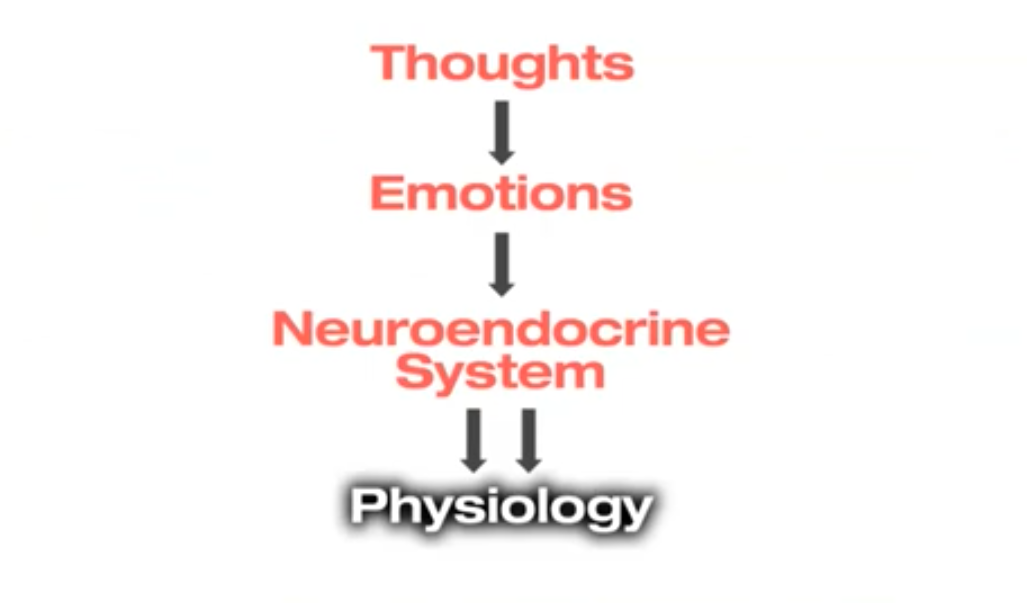

Then you can have a completely different experience as well, again with the physiology, thoughts and emotions. For example, let us look at two people who want to be intimate with each other. This is a completely different experience in the body but again the thoughts and emotions go on. The endocrine system picks up on those and then it translates them into the physiology and prepares the body for what it wants to do.
Garrett: When I was at the top of the hill and Avril said “That’s a bear!”, I could feel as soon as I had that information how my physiology changed very rapidly from a relaxed beautiful day in the mountains to something completely different. This is what we mean by “it translates the thoughts and emotions into the physiology” and now let us unpack what we mean by “thoughts and emotions” because there are a few nuances we want to explain here. Again, this is to lay the premise for why we take the approach we do.
The Internal Monologue
Now, I am going to play the DJ in this situation:
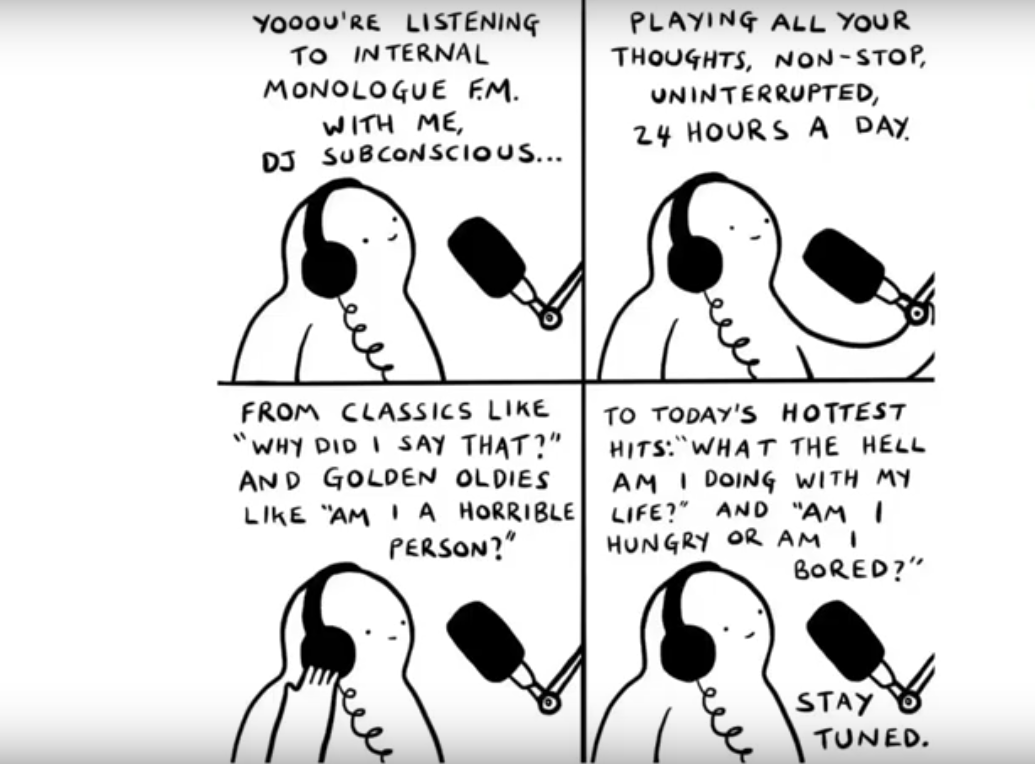

You’re listening to Internal Monologue FM with me DJ Subconscious playing all of your thoughts non-stop, uninterrupted, 24 hours a day. From classics like “Why did I say that?” to golden oldies like “Am I a horrible person?” to today’s hottest hits “What the hell am I doing with my life?” and “Am I hungry or am I bored?”. Stay tuned!
We want to put this up as quite humorous from our perspective in the sense that not only there are conscious thoughts that we are aware of but there are subconscious thoughts and things that we are just conscious of. Like I’m conscious of the shirt that’s on my back when I focus on it but I am not thinking about it all the time, yet I can become conscious of it. There is a range of thoughts – ones I am fully aware of, ones I am semi-aware of or sometimes aware of and ones I am not aware of. That is happening for everyone and the subconscious is actually a lot larger than the conscious.
When I Have Trouble Sleeping …
Avril: Sometimes, I have trouble sleeping and I am actually trying to see my thoughts but I don’t always see them. I know that because I’m trying to think “Is there something that is keeping me awake because I want to sleep right now?” I think I am relaxed but there is something going on there. I can tell because my mind feels busy and my physiology is matching that when there is this amped up feeling. If I stay relaxed and take several deep breaths and tell myself “Okay, now relax, we’re going to go to sleep now…” then this can start changing the physiology and help me sleep or at least stay relaxed. That is not this amped up feeling anymore.
However, there have been other times when I would get really upset that I can’t sleep. Then the thoughts are kind of that I am feeling sorry for myself and that this is terrible. Then this has a different physique, this happens differently in my physiology where it actually amps me up more and keeps me awake even longer. I can feel my heart pounding, even getting sweaty sometimes. So, I can go in two different ways. There is the subconscious going on but then it moves into the conscious thoughts as well and I can see what I am telling myself here and now.
Garrett: Thank you, that is really good and of course we all want to be in this happy place but with this subconscious, conscious and all the different things that happen, sometimes we’ll find ourselves in this fearful, angry or sad place. It is not that we shouldn’t experience other emotions but there’s an influence from this subconscious. This is what we’re talking about when we speak about thoughts and emotions and we want to take that one step further. We want to talk about this in terms of the symptoms of the thoughts and emotions we’re having in our psychology and how that relates to our behaviours.
Now, our behaviours are stemming from these thoughts and emotions and if we go down to a really fundamental level here, if we drill down we will see this word map of very negative words. Of course, we can have positive thoughts and emotions too but when we get into these reactive behaviours where maybe you have heard the expression “someone pushed my buttons and then I found myself reacting and it was kind of out of nowhere”. We have all of these experiences in our life that are kind of fragmented and decoherent and not really fitting into a coherent whole. These will surface in our life, it is inevitable and all of a sudden I could be engaged, really embroiled in an argument. For example, I am arguing with the signpost because my buttons are pushed and I just can’t help myself but argue. So, these are the behaviour symptoms of those thoughts and emotions.
Coping Mechanisms in Stressful Situations?
When you look at this Covid and everything that’s happening with the lockdowns and stuff. All kinds of things are happening because of this situation – domestic violence is skyrocketing right now. This is an example of symptoms of the thoughts and emotions that are surfacing for people.
There is also alcohol abuse and people are self-medicating in different ways. People are isolating and there are lots of different ways to cope, some people perhaps are eating in order to soothe themselves so there are lots of different behaviors we can display. This is what we meant earlier with “it all starts in psychology”. It all starts in the thoughts and emotions and then eventually, because our physiology is matching it, it can start to translate into the body.
How is coMra Therapy Working?
Avril: It starts with us wanting to help the body to heal itself and this is how we actually put ourselves in the picture. In order to start using coMra Therapy, it already takes a different mindset to get into this place where you want to use it. It is a decision and saying “Hey, I think I don’t want to feel this way anymore and I know something is going on for me, so what can I do about it?”. It’s like the “I can do it” attitude and wanting something different because whatever is going on, it isn’t working. These thoughts and emotions that start coming up with even wanting to use coMra is where we start.


Here on the picture you see Dennis. There she is holding the coMra Delta device treating herself. This is a cross section of the medical terminal for the Delta. First of all, it’s us making this decision and then we apply coMra Therapy on the body. It is a coherent therapy, so the coherence that is in it, is coming through the therapy into our bodies. It is like a very pure emotion – very balanced emotion, balanced thoughts… So, that is the message that is coming through, this is how we are bringing coherence in and this is helping us to move through.
Garrett: Usually, we talk about coMra therapy in terms of biochemistry and biophysics but now because we laid this foundation, we can look at it in terms of very coherent thoughts. Imagine when you are thinking very coherent thoughts, we all know the experience of it and how it is affecting our physiology in a very positive way. Very balanced emotions again have a positive effect on our physiology. So, we can look at coMra in that respect too.
Avril: Simply, we are the conductor of our health and I love this expression “vote with your feet”. So, voting with our feet is about choosing what we want to support, choosing what we want to do. Do we want something that is uplifting or are we going to choose something that’s more destructive? Again with coMra therapy, it’s when we’re choosing to use coMra therapy, the mindset is “I want to do something for myself, I want to uplift myself.”
Whether this is on our own or with a practitioner, still we know that it’s something very positive for our bodies, for our life too. Because when we take responsibility and say “Hey I want to do this, I don’t want to keep handing my power over to somebody else!”, it’s very powerful, it makes a difference for ourselves and the others around us as well.
Garrett: It is empowering all around and to make a distinction, Avril is not referring to working with a practitioner – we are referring to something else. I don’t know how it is in other countries but in Canada we have free healthcare. So, why would I worry about my health? I don’t have to think about it. In other words, this is our power handed over to someone else to look after it for us. Just to set the distinction – we want to work together and have some support, we’re human beings we need that.
Now, we want to take a little bit different approach looking at the same thing, we’re just going to shift the focus to a little different angle here. We talk about our body reflecting our state of being through our hormones. If you look at thoughts and emotions, we all have the experience of when we feel very good and our energy levels in the body are automatically higher. We feel more energy, we feel more alert, more aware, more capable, more able. In every way it has an effect. So, if you look at this picture below, think of this as a cascade effect.


Thoughts and emotions are at the top of the cascade. They affect the energy which affects the function and then affects the structure. We talked earlier about “it all starts in the psychology and eventually will show up in the physiology”, here if you think about it in terms of this cascade, this is how it affects us.
If we have very uplifting positive thoughts, like when we are in love and think about this brand new relationship, then our energy is very high. Our body actually starts to function in a much better way at that point, compared to if we’re feeling low. This influences how the body builds its structures. By “structures” I mean putting cells together, building what’s inside the cells, building tissues, building systems etc. All of the structures in the body work more coherently.
The same thing happens again when we use coMra therapy. It increases the efficiency of energy production in the body which thereby means functioning at a higher level, a more coherent way of functioning. This in turn means the body can create better, more coherent structures. Which means we feel healthier.
More About Endocrine Disorders
We’re using this word “endocrine”, it is simply where the hormones come from for now. So, if you look at how the endocrine system functions – it’s a balance, rebalance, balance, rebalance… A continuous balance and rebalance to maintain a center, whatever that center is. In the example that we gave earlier with the bear in the woods, I needed an appropriate balance to be able to handle the situation. We couldn’t just run away like on an autopilot, we needed to be aware of our state of being and to walk away from the bear. We had to be conscious at that point. So, we always need physiology to respond.
If we get into a space where we can’t maintain that balance, this is where things start to happen. For example, we are all in this situation about Covid, where there’s a lot of stress. Now you are in this place of having to maintain a balance which the physiology needs – the matched perception of “I am stressed out, this is dangerous”. I’m not saying I personally see it that way, I’m just generalizing about how the media is portraying this. Everywhere you hear “this is dangerous, dangerous, dangerous…”, so this hormone cortisol is being pumped, pumped… people are afraid, afraid, afraid. The brains then keep producing a predominant set of hormones.
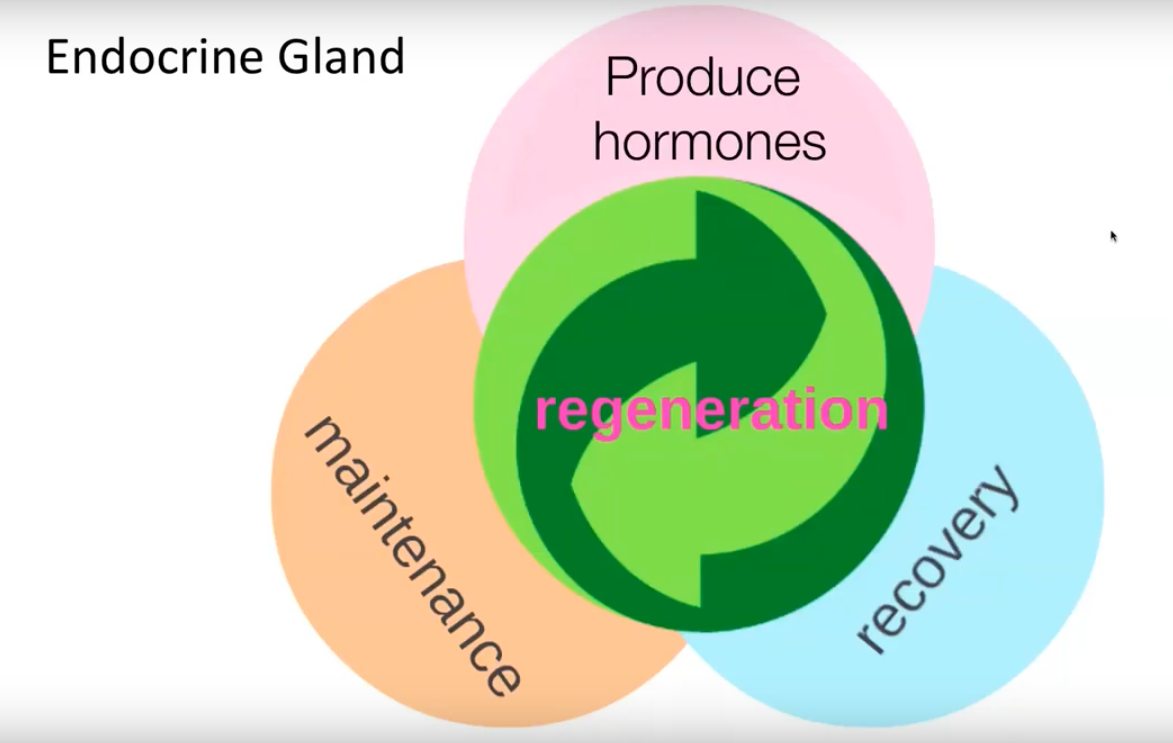

Usually, if we take the bear example, the situation has passed and I stopped producing that certain set of hormones to match it. Once we saw the beer wasn’t following us, then it all went into my adrenal glands. So, things now could go into recovery mode and after that maintenance but if we stay in this cortisol pumping, pumping, pumping… what happens is we impede the ability of the body to recover. Now, that gland can’t recover. Also, we impede the ability of the gland to maintain itself and as a result regeneration is going down. Of course, this means increased aging and we start to develop those hormonal imbalance symptoms that we looked at earlier.
If you think about it, it’s like a repetitive strain injury. Over time, if it happens again and again and again, we get a repetitive strain injury and we can’t function properly. The same thing with a gland – if it has to operate the same way over and over and over without a chance to regenerate, without a chance to have a dynamic balance of changing states, then it gets exhausted and can’t keep up. Then people wonder why they have this brain fog, for example. If you think about that in terms of someone goes to sleep but when they wake up in the morning they just can’t get out of bed. Now, the fact that they’re so exhausted makes them start having negative thoughts and emotions about themselves and it exacerbates the whole situation. This is why we take the approach we do with coMra.
coMra Treatment Approach to Endocrine Disorders
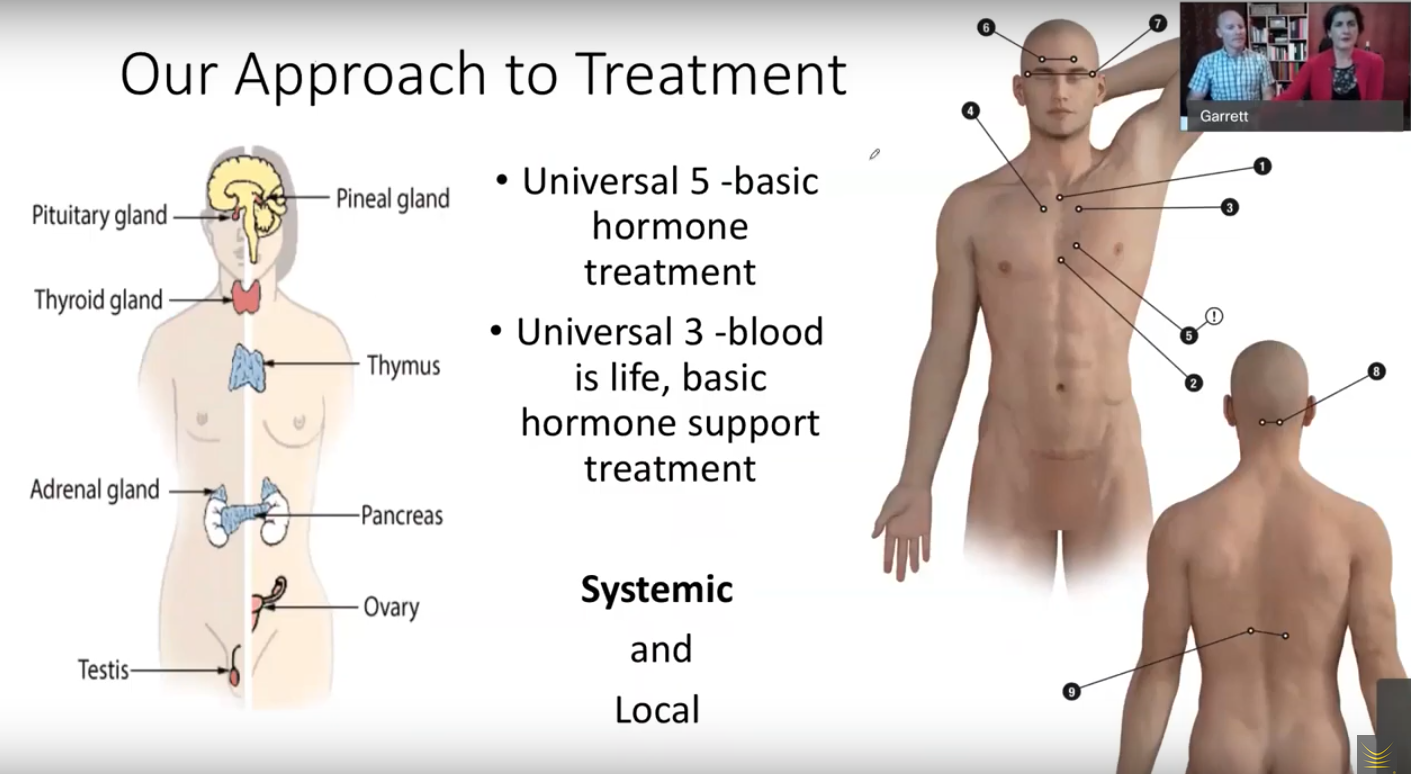

Avril: On the left here, we have a picture of where the endocrine glands are in the body and on the right we have an example of Universal treatment 5 from our User Guide, which we have called the hormone treatment. It addresses some of the disorders directly and then the support points are just that, they support the overall treatment. So, with any hormonal imbalance going on, this would be an excellent treatment to work with. It is basically a systemic treatment where we treat the pituitary and pineal gland and then the adrenals on the back. It is very important that they get treated too.
Also, Universal treatment 3 – Blood which we don’t have pictured here is a very important treatment for pretty much everything in the body. Therefore, with hormones it is quite beneficial because the hormones are circulating through the blood. It is always helpful when doing treatments with coMra therapy to not just put it on your skin but think about what you are treating here.
So, here will show one of our local treatments. This is one of the gynecology treatments from the coMra User Guide.


Anytime we are doing a local treatment, the systemic one is going to support it, so we want to do them both together. It is hugely important and the benefit from such a course is amazing, it makes a huge difference. With this gynecology example treatment, you can see all the things that can be addressed through working with just this treatment alone.
Practically speaking, if a woman has menstrual cramps she could do maybe two or three treatments throughout the day of this local treatment just to work with those symptoms – the cramping in that area etc. Then at one point in the day, she could do the Universal 5 in order to get her whole system in balance. That is really excellent.
Another treatment that we have listed there is the Liver treatment which is going to support liver detox. Again, this is important because the hormones are recycling through the liver. Liver regulates many processes in the body, so any support that we can give the liver is going to benefit the whole body.
Garrett: For anyone not familiar with coMra therapy, these treatments are in our User Guide which you can download or look at on our website. These here are just treatment examples however, there is much more in the User Guide. We have this huge list of symptoms which isn’t comprehensive or exhaustive, it is just a sum and we’re addressing these at a more fundamental level. This is clearly demonstrated here in this treatment because you can see all the things that are beginning to be addressed with the local treatment as well as the systemic treatment which will address even more. You don’t have to wait, you can be proactive with coMra therapy when something comes off or you think it is going to come up soon.
Avril: Also, coMra is a bridge with thoughts and emotions because those thoughts and emotions they’re not going to be resolved overnight. All these things have been developing since our childhood. So, coMra therapy is there to support us while we work through those deeper issues if we choose to do that.
Birth Control Pill and Other Medications
We just want to touch on a couple other aspects that can affect the balance of the hormones. Some medications can affect the hormones and the birth control pill is one of those as an example. Lots of women end up going on the birth control pill not only for birth control but also for skin issues, mood issues, their menstrual cramps when they have their cycle etc. Although it does help with those things, it does not actually balance anything because when a woman tries to quit taking the pill there’s just havoc going on in her body. She is just like an emotional mess, being very moody while different things are going on in her body.
Garrett: If you think about a medication that does the job of an endocrine gland for a while, the gland itself goes to sleep so to say. It doesn’t have to do the work anymore so when we want to stop that, then all of a sudden the gland has to learn how to function properly once again. Remember the list of symptoms, all these endocrine disorders and hormonal imbalances are not quick fixes. For example, if you bruise your elbow or something like that it would be a pretty quick fix. So, be prepared as there is an investment in yourself in terms of time and efforts.
Endocrine Disrupting Chemicals
Avril: The next aspect we are looking at is the environmental factors and specifically all the things that are called endocrine disrupting chemicals or EDC. These are ubiquitous in our environment, they are chemical contaminants and toxins which are direct insults to our hormonal balance.
There are thousands and thousands of toxins and chemicals out there and they actually created a category of chemicals that are called endocrine disrupting chemicals. So, it’s not unknown that they have an effect. It’s very clear as they have their own category. They are found and in the air, soil, water etc. They are in our food, in any foods that are sprayed with chemicals. Also in the cosmetics and personal care products which includes the menstrual protection products that women use right next to their body.
The list goes on with household products, cleaners, laundry supplies, plastics etc. These chemicals are almost everywhere around us. Even if we want to work to reduce these things in our environment as much as possible, no matter what we do in our homes and our own lives, they are still there. As they are everywhere, there is not really any escape but you can work to reduce these and as a result minimize the insult to the body. However, again coMra therapy is there for you even before these things start having an effect on the physiology through mimicking the hormones, blocking the hormones or interfering in some way. Each of them easily causes havoc in the body like the birth control pill does.
Garrett: As I said previously when I was talking about the balance and rebalance, these chemicals always add weight to one side of that scale and pull it off balance. So, we are encouraging people to use coMra to mitigate that effect because remember how this starts to lead to that the gland doesn’t get any rest. If you think about life in the sense of its changing dynamic balance, it is not a static balance, it is always in flux and change. So, when we get into a chronic illness, the balance is lost as the scale of our health gets locked into one spot and then the associated systems, glands, cells and tissues get exhausted.
We can use coMra therapy to mitigate those effects not only internally with our thoughts and emotions as a bridge but also as a bridge between us and our environment to help mitigate the negative effects.
Avril: Again we’re going to acknowledge the “vote with your feet”. What are the choices that we’re making? What am I choosing to support and nurture in my life? What am I choosing for myself, to support myself, to nurture myself, my health and well-being?
We are the conductors of our own healing and again we can get support from other people. It is not about doing it alone or anything like that. However, we are in the center, we are the ones in charge and we make those choices. It is very important to acknowledge ourselves for that as well when you do make those choices and realise “Hey, I actually got myself to this place where I can make this choice for myself and it uplifts me.” It is a very powerful thing to be taking responsibility and to put ourselves in the picture.
Garrett: Anybody who is using coMra therapy right now, please give yourself the credit that you do care about yourself and you are giving yourself that TLC (tender loving care). It is not a small thing because it really points to the mindset that Avril brought up earlier about “ I want to step in here, I want to take charge of my life, I want to look after myself and my family.” That is not to be taken for granted, it’s what we’re trying to say.
So with that, we come full circle to these common symptoms of hormonal imbalances.



We talked about a more fundamental level to start to address all these without talking about them specifically which is the usual way people would go about this. I feel this is a very unique way that many maybe have never heard of before or maybe you have. However, a lot of times when diagnosed with a hormonal imbalance it will be about whether we need to move this hormone down and this one up, or we need to adjust this one and that one. It is all about trying to do this job manually which probably skilled practitioners can do but really it is the body at the end of the day with the skills to manage this because it is always managing it anyway.
Rather than trying to make all of these adjustments manually, let’s go to a more fundamental level and support the body to do what it knows how to do best and that is match our physiology to our state of being. Then thereby it starts to resolve those imbalances and through coMra therapy we can provide the best support to the body in doing what it knows how to do best. Its job is to balance the hormones because that’s what it is always doing.
Then it comes back to that pricked finger with the cactus. If there is something going on with “I am feeling burnt out!” I am not going to take one pill for a burnout, a different pill for decreased mental clarity, another one for decreased sex drive etc. So, instead of “a pill for an ill”, we now take a more holistic approach. “Holism” is another word for coherence which is what coMra therapy is all about. This is an approach people take in their lives whether you use coMra or not, there is a coherent approach we can take in our lives and this is what we’re pointing to.
So, we are going to stop here. For more information visit our website: https://comra-palm.com/
Thank you for your time!
Watch the full video recording below:
